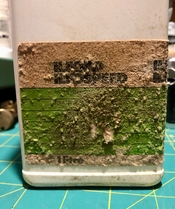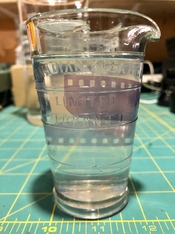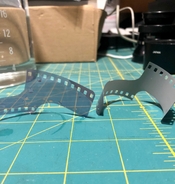Mike Té
Subscriber




I'm pleased, of course, but still wondering why there would be a separate product for paper.
Thanks for all the input!
All bottles are still full, vacuum-sealed (no slosh). I opened the ugliest bottle...
Smells fine, not strong, and as clear as spring water, no sediment and no crystals.
1 + 3 dilution, time to clear was 35s.
I'm pleased, of course, but still wondering why there would be a separate product for paper.
View attachment 314276 View attachment 314277 View attachment 314280 View attachment 314281
It passed the clip test, but that doesn't really show you how prints might hold up over time.
It depends on the pH. Neutral or alkaline fixer does not precipitate elemental sulphur. I have Agfa FX-Universal, unopened, from around 15 years ago which is still perfectly clear (pH around 7, made for C41 process but labelled by Agfa for black and white film and paper too).I’ve never had a fixer that did not go bad after 4 years. Sediments started to form after about 4 years.
good for you if it works
It depends on the pH. Neutral or alkaline fixer does not precipitate elemental sulphur. I have Agfa FX-Universal, unopened, from around 15 years ago which is still perfectly clear (pH around 7, made for C41 process but labelled by Agfa for black and white film and paper too).
In the case of the OP's old Ilford fixer, it would be interesting to know its pH.
Fixer has one job - to remove undeveloped silver. I don't think there's any mystery to that; if it clears the film, do a timed strip test on the paper you're printing with to find the minimum fixing time (I don't know why people test fixer for printing with a scrap of film). If it removes silver, your only archival worry is washing it from the print.
Ealrier comments were "fixer is fixer", but rapid fixer's a very different animal as far as fixing times go. I've purchased powdered fixer from Freestyle for 40" prints where I need a gallon+ (tryin' to save a buck), and it was vey slow stuff. A timed strip test will show you exactly (well, I do 15 second increments) how long it takes your current batch of fixer to clear the current paper you're printing with, so it takes fix exhaustion and silver levels in the paper into account. and it takes about 120 seconds to do it.
In the case of the OP's old Ilford fixer, it would be interesting to know its pH.
Interesting. I have an unopened jug of PF TF-4 that I bought when I had planned to return to darkroom work in 2015 or 16 (forget which) but never got around to. I rather assumed I'd just need to toss it. It looks clear and as you say no sediment. So it's probably fine?
Isn't TF-4 the fixer that had some undissolved component and needed to be shaken before dilution?
Like others, I think that's very old over 30 years, probably 1989 for an Ilfospeed processor. The first generation of Ilfospeed paper was developer incorporated, I'd been given an Ilfoprint Rapid Access processor and tried the Ilfoprint Activator, but it wasn't ideal, so I made my own, just a mix of Sodium Hydroxide, Sodium Sulphite and Potassium Bromide, no developing agents, and it was perfect. But Ilfospeed II dropped the developer incorporation.
It's likely the Ilfospeed Fixer is more concentrated than current Ilford fixers, it may be a super fixer containing Thiocyanate as well as Thiosulphate to ensure the very fast throughput of the Roller transport processors.
Ian
| Photrio.com contains affiliate links to products. We may receive a commission for purchases made through these links. To read our full affiliate disclosure statement please click Here. |
PHOTRIO PARTNERS EQUALLY FUNDING OUR COMMUNITY:  |


